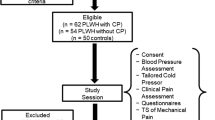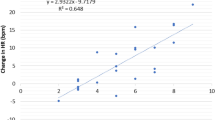Abstract
The multidimensional experience of pain is thought to be partially influenced by the pain modulation system as well as by individual psychological components. Recent studies demonstrated possible common neural network mediating both domains. The present study examined the relationships between pain perception, pain modulation, and catastrophizing in healthy subjects. Forty-eight participants (29 females and 19 males) completed the pain catastrophizing scale (PCS) and underwent psychophysical tests in order to evaluate the modulation of pain, using the diffuse noxious inhibitory control (DNIC) paradigm. Contact heat pain (47.0°C applied for 1 min), which was used as the “test” stimulation, was applied before and after a physical effort that induces pain (repeated squeezing of a hand grip device), which was used as a “conditioning” stimulus. Numeric pain scale intensities (NPS, 0–10) were evaluated four times during each of two separate consecutive runs of heat stimulation. Results showed a significant positive correlation of PCS with heat pain (r = 0.48, p < 0.0005) and with muscle pain (r = 0.31, p = 0.03). In addition, significant negative correlations were found between PCS and DNIC effect (r = −0.34, p = 0.02). Moreover, once catastrophizing was entered into the regression analysis, the previously significant effect of gender was no longer found. In conclusion, individuals with high catastrophizing levels demonstrated higher pain intensities and lower effects of DNIC indicating that catastrophizing might have a significant impact on pain perception via an association with pain modulation.


Similar content being viewed by others
References
Apkarian AV, Sosa Y, Sonty S, Levy RM, Harden RN, Parrish TB, Gitelman DR (2004) Chronic back pain is associated with decreased prefrontal and thalamic gray matter density. J Neurosci 24:10410–10415
Baad-Hansen L, Poulsen HF, Jensen HM, Svensson P (2005) Lack of sex differences in modulation of experimental intraoral pain by diffuse noxious inhibitory controls (DNIC). Pain 116:359–365
Brighina F, Piazza A, Vitello G, Aloisio A, Palermo A, Daniele O, Fierro B (2004) rTMS of the prefrontal cortex in the treatment of chronic migraine: a pilot study. J Neurol Sci 227:67–71
Casey KL, Lorenz J, Minoshima S (2003) Insights into the pathophysiology of neuropathic pain through functional brain imaging. Exp Neurol 184(Suppl 1):S80–S88
Desbois C, Villanueva L (2001) The organization of lateral ventromedial thalamic connections in the rat: a link for the distribution of nociceptive signals to widespread cortical regions. Neuroscience 102:885–898
Desbois C, Le Bars D, Villanueva L (1999) Organization of cortical projections to the medullary subnucleus reticularis dorsalis: a retrograde and anterograde tracing study in the rat. J Comp Neurol 410:178–196
Edwards RR (2005) Individual differences in endogenous pain modulation as a risk factor for chronic pain. Neurology 65:437–443
Edwards RR, Ness TJ, Weigent DA, Fillingim RB (2003) Individual differences in diffuse noxious inhibitory controls (DNIC): association with clinical variables. Pain 106:427–437
Edwards RR, Fillingim RB, Maixner W, Sigurdsson A, Haythornthwaite J (2004) Catastrophizing predicts changes in thermal pain responses after resolution of acute dental pain. J Pain 5:164–170
Edwards RR, Campbell CM, Fillingim RB (2005) Catastrophizing and experimental pain sensitivity: only in vivo reports of catastrophic cognitions correlate with pain responses. J Pain 6:338–339
Edwards RR, Bingham CO 3rd, Bathon J, Haythornthwaite JA (2006a) Catastrophizing and pain in arthritis, fibromyalgia, and other rheumatic diseases. Arthritis Rheum 55:325–332
Edwards RR, Smith MT, Stonerock G, Haythornthwaite JA (2006b) Pain-related catastrophizing in healthy women is associated with greater temporal summation of and reduced habituation to thermal pain. Clin J Pain 22:730–737
Fillingim RB (2005) Individual differences in pain responses. Curr Rheumatol Rep 7:342–347
France CR, Suchowiecki S (1999) A comparison of diffuse noxious inhibitory controls in men and women. Pain 81:77–84
France CR, France JL, al’Absi M, Ring C, McIntyre D (2002) Catastrophizing is related to pain ratings, but not nociceptive flexion reflex threshold. Pain 99:459–463
France CR, Keefe FJ, Emery CF, Affleck G, France JL, Waters S, Caldwell DS, Stainbrook D, Hackshaw KV, Edwards C (2004) Laboratory pain perception and clinical pain in post-menopausal women and age-matched men with osteoarthritis: relationship to pain coping and hormonal status. Pain 112:274–281
Fujii K, Motohashi K, Umino M (2006) Heterotopic ischemic pain attenuates somatosensory evoked potentials induced by electrical tooth stimulation: diffuse noxious inhibitory controls in the trigeminal nerve territory. Eur J Pain 10:495–504
Ge HY, Madeleine P, Arendt-Nielsen L (2004) Sex differences in temporal characteristics of descending inhibitory control: an evaluation using repeated bilateral experimental induction of muscle pain. Pain 110:72–78
Goffaux P, Redmond WJ, Rainville P, Marchand S (2007) Descending analgesia: when the spine echoes what the brain expects. Pain 130(1):137–143
Gracely RH, Geisser ME, Giesecke T, Grant MA, Petzke F, Williams DA, Clauw DJ (2004) Pain catastrophizing and neural responses to pain among persons with fibromyalgia. Brain 127:835–843
Granot M, Ferber SG (2005) The roles of pain catastrophizing and anxiety in the prediction of postoperative pain intensity: a prospective study. Clin J Pain 21:439–445
Granot M, weissman-Fogel I, Crispel Y, Pud D, Granovsky Y, Sprecher E, Yarnitsky D (2007) Determinants of endogenous analgesia magnitude in a diffuse noxious inhibitory control (DNIC) paradigm: do conditioning stimulus painfulness, gender and personality variables matter? Pain 27 [Epub ahead of print]
Hardy SG (1985) Analgesia elicited by prefrontal stimulation. Brain Res 339:281–284
Hardy SG, Haigler HJ (1985) Prefrontal influences upon the midbrain: a possible route for pain modulation. Brain Res 339:285–293
Hutchison WD, Harfa L, Dostrovsky JO (1996) Ventrolateral orbital cortex and periaqueductal gray stimulation-induced effects on on- and off-cells in the rostral ventromedial medulla in the rat. Neuroscience 70:391–407
Jacobsen PB, Butler RW (1996) Relation of cognitive coping and catastrophizing to acute pain and analgesic use following breast cancer surgery. J Behav Med 19:17–29
Julien N, Goffaux P, Arsenault P, Marchand S (2005) Widespread pain in fibromyalgia is related to a deficit of endogenous pain inhibition. Pain 114:295–302
Keefe FJ, Lefebvre JC, Egert JR, Affleck G, Sullivan MJ, Caldwell DS (2000) The relationship of gender to pain, pain behavior, and disability in osteoarthritis patients: the role of catastrophizing. Pain 87:325–334
Kosek E, Hansson P (1997) Modulatory influence on somatosensory perception from vibration and heterotopic noxious conditioning stimulation (HNCS) in fibromyalgia patients and healthy subjects. Pain 70:41–51
Lautenbacher S, Rollman GB (1997) Possible deficiencies of pain modulation in fibromyalgia. Clin J Pain 13:189–196
Le Bars D (2002) The whole body receptive field of dorsal horn multireceptive neurones. Brain Res Brain Res Rev 40:29–44
Le Bars D, Dickenson AH, Besson JM (1979) Diffuse noxious inhibitory controls (DNIC). I. Effects on dorsal horn convergent neurones in the rat. Pain 6:283–304
Le Bars D, Bouhassira D, Villanuera L (1995) Opioids, diffuse noixious inhibitory controls in the rat. In: B. Bromm JE Desmendt (eds) “ Pain, the brain: from nociceptor to cortical activity”, advances in pain research and therapy Vol. 22. Raven, New York, pp 517–539
Lorenz J, Minoshima S, Casey KL (2003) Keeping pain out of mind: the role of the dorsolateral prefrontal cortex in pain modulation. Brain 126:1079–1091
Maixner W, Fillingim R, Booker D, Sigurdsson A (1995) Sensitivity of patients with painful temporomandibular disorders to experimentally evoked pain. Pain 63:341–351
Monconduit L, Villanueva L (2005) The lateral ventromedial thalamic nucleus spreads nociceptive signals from the whole body surface to layer I of the frontal cortex. Eur J Neurosci 21:3395–3402
Peyron R, Garcia-Larrea L, Gregoire MC, Costes N, Convers P, Lavenne F, Mauguiere F, Michel D, Laurent B (1999) Haemodynamic brain responses to acute pain in humans: sensory and attentional networks. Brain 122(Pt 9):1765–1780
Pielsticker A, Haag G, Zaudig M, Lautenbacher S (2005) Impairment of pain inhibition in chronic tension-type headache. Pain 118:215–223
Pud D, Sprecher E, Yarnitsky D (2005) Homotopic and heterotopic effects of endogenous analgesia in healthy volunteers. Neurosci Lett 380:209–213
Rhudy JL, Maynard LJ, Russell JL (2007) Does in vivo catastrophizing engage descending modulation of spinal nociception? J Pain 8:325–333
Sandrini G, Rossi P, Milanov I, Serrao M, Cecchini AP, Nappi G (2006) Abnormal modulatory influence of diffuse noxious inhibitory controls in migraine and chronic tension-type headache patients. Cephalalgia 26:782–789
Schouenborg J, Dickenson A (1985) Effects of a distant noxious stimulation on A and C fibre-evoked flexion reflexes and neuronal activity in the dorsal horn of the rat. Brain Res 328:23–32
Seminowicz DA, Davis KD (2006) Cortical responses to pain in healthy individuals depends on pain catastrophizing. Pain 120:297–306
Serrao M, Rossi P, Sandrini G, Parisi L, Amabile GA, Nappi G, Pierelli F (2004) Effects of diffuse noxious inhibitory controls on temporal summation of the RIII reflex in humans. Pain 112:353–360
Severeijns R, Vlaeyen JW, van den Hout MA, Weber WE (2001) Pain catastrophizing predicts pain intensity, disability, and psychological distress independent of the level of physical impairment. Clin J Pain 17:165–172
Staud R, Robinson ME, Price DD (2005) Isometric exercise has opposite effects on central pain mechanisms in fibromyalgia patients compared to normal controls. Pain 118:176–184
Staud R, Robinson ME, Vierck CJ Jr, Price DD (2003) Diffuse noxious inhibitory controls (DNIC) attenuate temporal summation of second pain in normal males but not in normal females or fibromyalgia patients. Pain 101:167–174
Stewart SH, Asmundson GJ (2006) Anxiety sensitivity and its impact on pain experiences and conditions: a state of the art. Cogn Behav Ther 35:185–188
Sullivan MJ, Stanish W, Waite H, Sullivan M, Tripp DA (1998) Catastrophizing, pain, and disability in patients with soft-tissue injuries. Pain 77:253–260
Sullivan MJL, Tripp DA, Santor D (2000) Gender differences in pain and pain behavior: the role of catastrophizing. Cog Ther Res 24:121–134
Sullivan MJ, Thorn B, Haythornthwaite JA, Keefe F, Martin M, Bradley LA, Lefebvre JC (2001) Theoretical perspectives on the relation between catastrophizing and pain. Clin J Pain 17:52–64
Sullivan MJ, Rodgers WM, Wilson PM, Bell GJ, Murray TC, Fraser SN (2002) An experimental investigation of the relation between catastrophizing and activity intolerance. Pain 100:47–53
Sullivan MJ, Lynch ME, Clark AJ (2005) Dimensions of catastrophic thinking associated with pain experience and disability in patients with neuropathic pain conditions. Pain 113:310–315
Talbot JD, Duncan GH, Bushnell MC, Boyer M (1987) Diffuse noxious inhibitory controls (DNICs): psychophysical evidence in man for intersegmental suppression of noxious heat perception by cold pressor pain. Pain 30:221–232
Terkelsen AJ, Andersen OK, Hansen PO, Jensen TS (2001) Effects of heterotopic- and segmental counter-stimulation on the nociceptive withdrawal reflex in humans. Acta Physiol Scand 172:211–217
Thorn BE, Clements KL, Ward LC, Dixon KE, Kersh BC, Boothby JL, Chaplin WF (2004) Personality factors in the explanation of sex differences in pain catastrophizing and response to experimental pain. Clin J Pain 20:275–282
Turner JA, Jensen MP, Warms CA, Cardenas DD (2002) Catastrophizing is associated with pain intensity, psychological distress, and pain-related disability among individuals with chronic pain after spinal cord injury. Pain 98:127–134
Villanueva L, Le Bars D (1995) The activation of bulbo-spinal controls by peripheral nociceptive inputs: diffuse noxious inhibitory controls. Biol Res 28:113–25
Villanueva L, Desbois C, Le Bars D, Bernard JF (1998) Organization of diencephalic projections from the medullary subnucleus reticularis dorsalis and the adjacent cuneate nucleus: a retrograde and anterograde tracer study in the rat. J Comp Neurol 390:133–160
Zhang S, Tang JS, Yuan B, Jia H (1997) Involvement of the frontal ventrolateral orbital cortex in descending inhibition of nociception mediated by the periaqueductal gray in rats. Neurosci Lett 224:142–146
Author information
Authors and Affiliations
Corresponding author
Rights and permissions
About this article
Cite this article
Weissman-Fogel, I., Sprecher, E. & Pud, D. Effects of catastrophizing on pain perception and pain modulation. Exp Brain Res 186, 79–85 (2008). https://doi.org/10.1007/s00221-007-1206-7
Received:
Revised:
Accepted:
Published:
Issue Date:
DOI: https://doi.org/10.1007/s00221-007-1206-7




